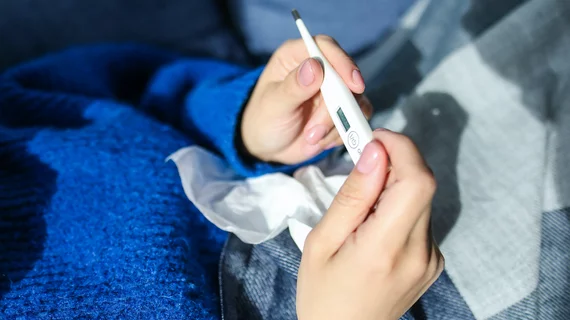Aided by AI, a tiny device may offer nearly instant testing for COVID, seasonal flu
Researchers have developed a nanopore that uses AI to detect COVID-19 and other viruses in easily obtained saliva specimens.
In testing, the device needed just five minutes to confirm positive cases at a 90% clip and rule out negatives with 96% specificity.
A nanopore is a miniscule device—around a billionth of a meter wide—that replicates a pore on the skin. It can be placed on a membrane to measure the flow of electric current through its opening. These measurements can reveal processes taking place at molecular and genetic levels.
The COVID advance in nanopore technology for virology unfolded at Osaka University in Japan and is described in a study published June 17 in Nature Communications.
Masateru Taniguchi, PhD, and colleagues tried various approaches before settling on a platform they call the artificially intelligent nanopore. Its relatively simple setup combines software on a server with a portable current-measuring instrument and “scalable, cost-effective” semiconducting nanopore modules.
The team trained their successful algorithms not on data from cultured viruses as might be expected but, instead, on positive and negative specimens obtained from the nose or throat for reverse transcription-polymerase chain reaction (RT-PCR) testing.
“By modifying the training data, [we made] the platform … a versatile virus diagnostic system,” the authors write.
The artificially intelligent nanopore showed its chops for differential diagnoses when Taniguchi and colleagues used it to additionally identify several seasonal flu viruses.
The flu can bring on symptoms closely similar to those caused by COVID—fever, cough, sore throat, body aches—so a quick saliva test would be helpful when patients present with any combination of flulike symptoms, they note.
“According to this study, machine learning of the cultured SARS-CoV-2 (COVID-19) and influenza A virus (H1N1) [proved] an extremely high discriminator,” Taniguchi et al. write.
“When the clinical specimens collected from patients infected with each virus are used as training data,” they add, “the identification result of the cultured viruses will enable the development of a device that can diagnose both viruses with high accuracy.”
Further:
The current characteristics obtained from the nanopore largely depend not only on the electrical characteristics of the nanopore but also on the electrical characteristics of the measuring device and the fluidic device that transports the specimen to the nanopore. Therefore, the development of a dedicated measuring device and flow channel suitable for the nanopores has also been a major limitation in realizing a highly accurate diagnostic system. In the current study, we have developed an artificial intelligence-assisted nanopore-based device to accurately detect the viruses.”
The study is available in full for free.

